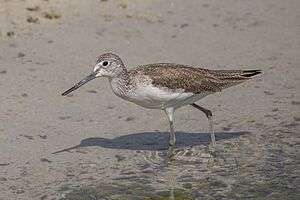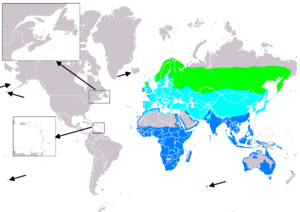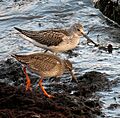Common greenshank facts for kids
Quick facts for kids Common greenshank |
|
|---|---|
 |
|
| Summer plumage, Standlake, Oxfordshire | |
 |
|
| Winter plumage, Bahrain |
|
| Conservation status | |
| Scientific classification | |
 |
|
| Range of T. nebularia Breeding Non-breeding Passage Vagrant (seasonality uncertain) | |
| Synonyms | |
|
The common greenshank (Tringa nebularia) is a type of wader bird. Waders are birds that often live near water and have long legs. This bird belongs to a big family called Scolopacidae. The name Tringa comes from an old word for a wading bird. The word nebularia comes from a Latin word meaning "mist." This name fits because greenshanks like to live in damp, marshy places.
Where They Live
This bird lives in cool, northern areas. It breeds in places like northern Scotland and across northern Europe. You can also find it further east in Asia.
The common greenshank is a migratory bird. This means it travels long distances. When winter comes, it flies south to Africa, India, and Australia. It usually stays near fresh water during winter.
When it's time to have babies, the greenshank finds dry ground near wet, marshy areas. It makes a simple nest on the ground. This nest is just a small dip where it lays about four eggs.
What They Look Like
Common greenshanks look different depending on the season. In summer, when they are breeding, their feathers are brown. In winter, they turn a grey-brown color.
These birds have long, greenish legs. Their bill is also long and has a grey base. The tip of their bill looks a bit upturned. When they fly, you can see a clear white patch on their back.
Greenshanks are a bit bigger than their relatives, like the common redshank. You can often hear them before you see them. Their call is a quick series of three clear, flute-like notes. It sounds like teu-teu-teu.
Like most waders, greenshanks eat small invertebrates. These are tiny creatures without backbones, like worms or insects. They also like to eat small fish and amphibians, such as frogs.
The common greenshank is part of an important agreement. This agreement helps protect migratory waterbirds in Africa and Europe. In Australia, the common greenshank is considered an endangered bird as of 2024. This means there are concerns about its numbers.
Gallery
-
Common greenshank is significantly larger than, for example Common redshank.





